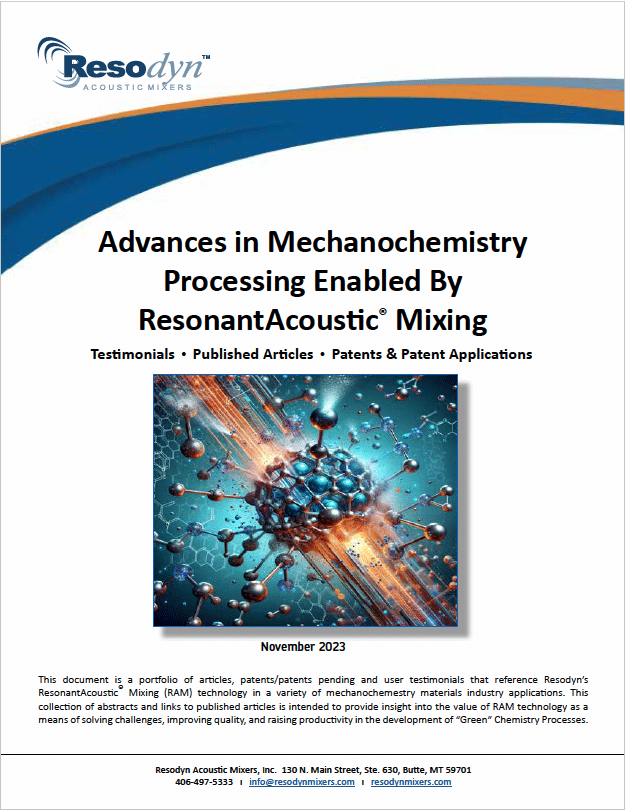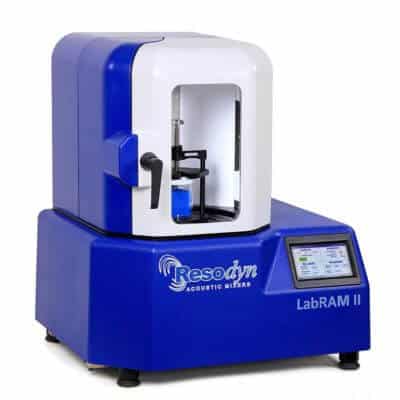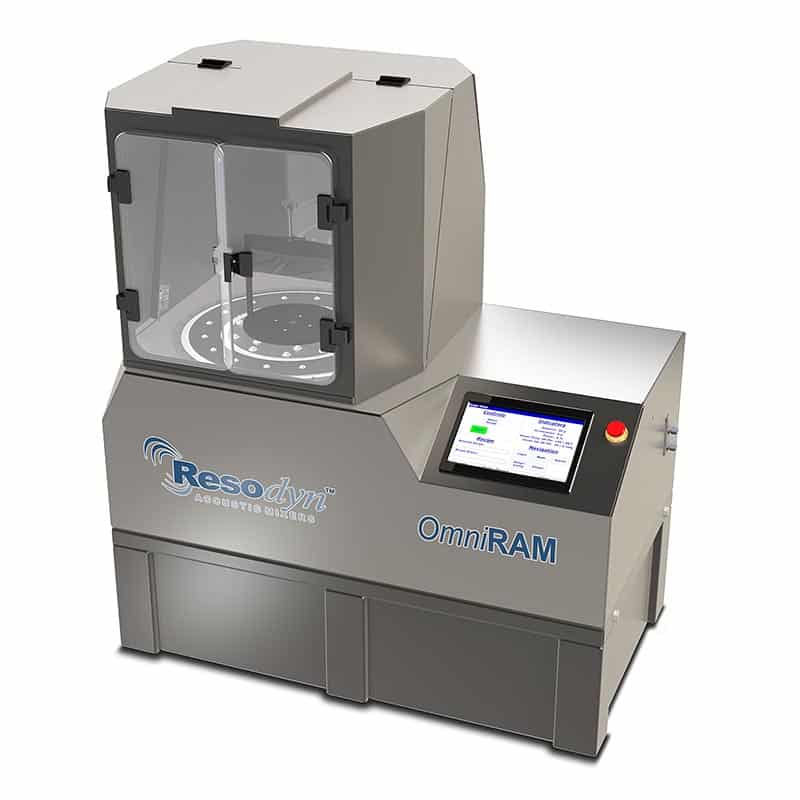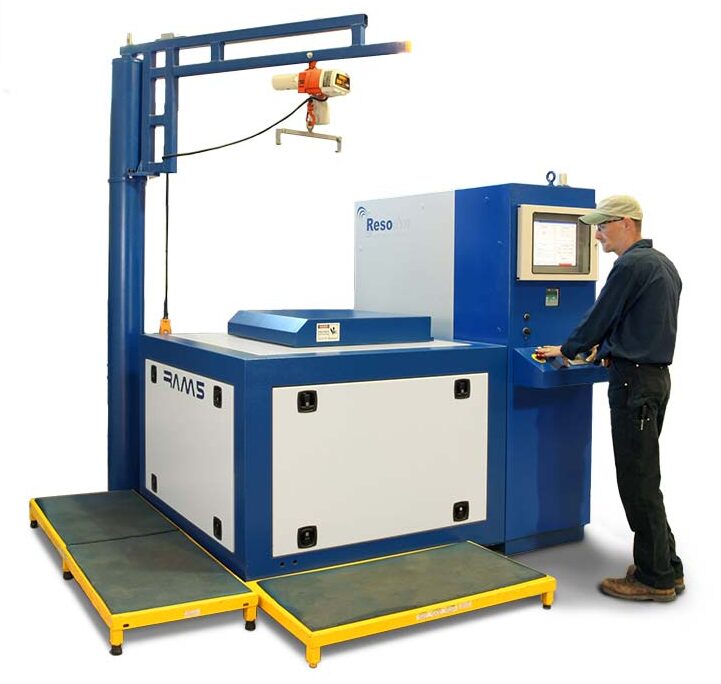



Home » Industries Served » Chemical Mixers | Chemical Mixing Equipment | Mechanochemistry
ONLY RAM GIVES YOU ACCURACY, REPEATABILITY & PURITY IN CHEMICAL MIXING & DEVELOPMENT
Resonant Acoustic Mixing (RAM) is increasingly used in chemical mixing process because it solves many challenges that traditional mixing methods can't handle efficiently or safely. Here's how it's being used successfully in chemical mixing applications worldwide:
1. Homogeneous Mixing of Multi-Phase Chemicals
RAM chemical processes can mix liquids, solids, gases, and their combinations uniformly, even when viscosities differ drastically or when materials are immiscible (like oil and water).
Success Example:
Blending liquid-liquid reactants with vastly different viscosities (e.g., glycerin with hexane) without creating emulsions or requiring surfactants.
2. Mechanochemistry (Solid-State Reactions)
RAM enables chemical reactions between solid reactants—no solvents needed. This is called mechanochemistry, and RAM excels here because it delivers high energy without direct contact.
Success Example:
Synthesizing metal-organic frameworks (MOFs), catalytic powders, or organics without solvents, reducing environmental impact.
Check out RAM and mechanochemistry in the digital exhibit, Mix, Crush, Shear from the Science History Institute's website.
3. In-Situ Reactions in Closed Containers
RAM can perform chemical reactions directly in sealed vessels, maintaining an inert atmosphere (e.g., nitrogen or argon) or applying vacuum or temperature control with jacketed containers.
Success Example:
Reactive blending of hazardous or air-sensitive chemicals without exposure or cleanup.
4. Coating, Encapsulation & Surface Modification
RAM uniformly coats powders, particles, or granules with chemical layers (e.g., polymers, catalysts, lubricants) without using excess solvents or binders.
Success Example:
Applying anti-caking agents or chemical coatings to explosives or energetic materials (used by DoD and NASA).
5. Ultra-Fast Reaction Times
RAM significantly shortens reaction and mixing times due to high energy transfer—mixing is often 10x to 100x faster than traditional mixers.
Success Example:
Speeding up polymer precursor mixing or batch chemical synthesis where reaction kinetics are limited by diffusion.
Why It Works So Well in Chemical Applications
-
No blades or shafts: Zero shear degradation of sensitive reactants.
-
Non-contact: No contamination and easy cleanup—especially valuable for hazardous or toxic chemicals.
-
Consistent energy distribution: Results in repeatable, scalable reactions.
-
High safety profile: Used in defense, pharma, and aerospace for sensitive or explosive chemistries.
Typical Chemical Mixing Use Cases
-
Polymer blending and compounding
-
Catalysis and catalyst support coating
-
Solvent-free reactions
-
Nanomaterial dispersion
-
Battery material preparation (e.g., anodes, cathodes)
-
Pharmaceutical synthesis and API mixing
When it comes to mixing equipment RAM mixers provide 10X to 100X faster mixing and dispersion rates second to none with increased intra-batch uniformity and consistency.
Both heating and cooling systems can be applied for tighter reactive process control and increased consistency of the chemical blending process.
Rapid emulsification and extended life suspensions provide immense benefits to chemical mixing with RAM.
Applications for RAM products in the Chemical Mixer Industry is uncapped and inclusive of:
- Catalysts
- Chlorinated Organics
- Epoxy Hardeners
- Floatation Reagents
- Gas Storage Materials
- Lubricant Pastes & Oils
- Mechanochemistry
- Optical Brighteners
- PVB Emulsions
- Specialty Chemicals
- Technical Polymers
- Thermal Transfer Materials
- And Many More

5 Little-Known RAM Examples of Chemical Mixing Success
Resonant Acoustic Mixing (RAM) has been successfully applied in various chemical mixing processes, offering advantages such as solvent-free reactions, enhanced mixing efficiency, and scalability. Here are some notable examples:
1. Solvent-Free Buchwald-Hartwig Amination
Researchers have utilized RAM for the Buchwald-Hartwig amination reaction without the need for bulk solvents. By systematically varying parameters like filling ratio, acceleration, and liquid additive amount, they achieved efficient and scalable reactions, highlighting RAM's potential in green chemistry applications. chemrxiv.org
2. Multigram-Scale Organic Synthesis
A study demonstrated the use of RAM for multigram-scale organic reactions, including the Knoevenagel condensation and Michael addition. The results showed that RAM could efficiently facilitate these reactions without the need for milling media, simplifying the process and reducing contamination risks. chemistry-europe.onlinelibrary.wiley.compubs.rsc.org+2nature.com+2onlinelibrary.wiley.com+2
3. Halogen-Bonded Cocrystal Formation
RAM has been employed to synthesize halogen-bonded cocrystals through neat and liquid-assisted mixing. This method offers a gentle mechanochemical approach, enabling the formation of cocrystals without the need for extensive solvent use or mechanical grinding. researchgate.net+7pubs.rsc.org+7sciencedirect.com+7
4. Synthesis of DNA and RNA Fragments
In the field of nucleic acid chemistry, RAM has been applied to synthesize short DNA and RNA fragments without bulk solvents. This approach significantly reduces solvent usage and allows for efficient coupling reactions, demonstrating RAM's applicability in sensitive biochemical processes. pubs.rsc.org
5. Photo-Mechanochemical Reactions
RAM has been explored as a platform for photo-mechanochemical applications, combining mechanical mixing with photochemical reactions. This integration enables sustainable and efficient synthesis pathways, expanding the scope of RAM in advanced material synthesis. nature.com
These examples underscore RAM's versatility and effectiveness in chemical mixing and synthesis, offering cleaner, faster, and more scalable alternatives to traditional methods. If you're interested in more detailed information or specific applications, feel free to ask!
Ready to find out more?
Drop us a line for a free demo or quote!
CHEMICAL MIXER
CASE STUDIES
“ResonantAcoustic® Mixing (RAM) enables mechanochemical organic synthesis that avoids milling or crushing media, as well as bulk solvents. The RAM methodology enables significant simplification and improvement of mechanochemical olefin metathesis, the first mechanochemical strategy for ene-yne metathesis, and permits the direct, 200-fold scaling-up of the mechanochemical synthesis of pharmaceutically active sulfonylureas, without any significant changes to reaction conditions or conversion. ”
- Angewandte Chemie International Edition, 2022
“Our Testing with ResonantAcoustic® technology has demonstrated filler incorporation at phenomenal rates and with very little viscous heating. This technology could have a far broader impact on the Chemical Industry than anyone is imagining today”
- Senior Process engineering specialist – Global Chemical Company
“The use of resonant acoustic mixing as a simple, rapid and readily scalable methodology for synthesizing metal–organic frameworks of different levels of complexity, including two- and three-dimensional networks, has been demonstrated”
–Chemical Science, 2020
THE UNIVERSAL BATCH
CHEMICAL MIXING SOLUTION
The ResonantAcoustic® Mixer (RAM) product line harnesses the power of resonance (low-frequency sound) to generate powerful and efficient chemical mixing of complex Solid-Solid, Solid-Liquid, Liquid-Gas, and Liquid-Liquid Blends. RAM systems provide;
- 10-100X faster mixing times
- bladeless non-contact mixing
- consistent homogenization
- end cross contamination
- repeatable every time
- scalable
- made in the USA
- custom engineered systems
- built to last
- amazing cost savings
- eco-friendly operation
- unmatched safety
Videos on Mechanochemistry and Chemical Mixing
ResonantAcoustic® Mixing (RAM) Mixing Minute - Mechanochemistry
Dr. Tomislav Friščić - Leverhulme International Professor in Green and Sustainable Chemistry at the University of Birmingham in the UK explains the INCREDIBLE benefits of ResonantAcoustic® Mixing (RAM) in the field of Mechanochemistry over legacy technologies at Resodyn's Technical Interchange.
Client Testimonial - Hyaluronic Acid Crosslinking in as little as 1 minute with ResonantAcoustic Mixing!
ResonantAcoustic® Mixing (RAM) for Innovation in Cosmetics and Pharmaceuticals.
Successful application of ResonantAcoustic® Mixing (RAM) technology to Hyaluronic Acid (HA) crosslinking leads to significant technological advantages and at the same time allows crosslinked HA gels.
Polymer and Viscous Liquid Blending in 4 Seconds!
Many polymer based processing applications require additional ingredients for performance or coloration. To illustrate RAM’s ability to quickly and thoroughly mix ingredients of different characteristics, 2.5 grams of food coloring was blended with 235 grams of a polymer surrogate in 4 seconds! The final mixture shows the liquid fully dispersed within the polymer due to the unique and effective mixing action captured in the high speed footage.
Uniform Blending of Dissimilar Powders in 10 Seconds!
Dry ingredients can be difficult to thoroughly and consistently mix, particularly when the particles are of different sizes and characteristics. To illustrate effective and rapid mixing, 10 grams of fumed silica is blended with 100 grams of sand in 10 seconds! Completed specimens exhibit no airborne fumed silica, demonstrating uniform blending at an order of magnitude difference in particle size.
Published Articles on Mechanochemistry and Chemical Mixing Processes
Mechanochemical Synthesis of Boroxine-linked Covalent Organic Frameworks
Materials Chemistry
https://doi.org/10.26434/chemrxiv-2024-d7znt
Enhancement of Co2 Adsorption Kinetics Onto Carbon by Low-Frequency High Amplitude Resonant Vibrations
Carbon Trends
https://doi.org/10.1016/j.cartre.2024.100361
Solvent-free surface modification of milled carbon fiber using resonant acoustic mixing
Applied Surface Science
https://doi.org/10.1016/j.apsusc.2023.158865
Halogen-bonded cocrystals via resonant acoustic mixing
Mechanochemistry
https://doi.org/10.1039/d3mr00028a
Resonant acoustic mixing (RAM) for efficient mechanoredox catalysis without grinding or impact media
Chemical Communications
https://doi.org/10.1039/d2cc06013b
Milling Media-Free Suzuki Coupling by Direct Mechanocatalysis- From Mixer Mills to Resonant Acoustic Mixers
European Journal
https://doi.org/10.1002/chem.202301714
Direct mechanocatalysis by resonant acoustic mixing (RAM)
Chemical Science
https://doi.org/10.1039/d3sc01591b
The “η-sweet-spot” (ηmax) in liquid-assisted mechanochemistry: polymorph control and the role of a liquid additive as either a catalyst or an inhibitor in resonant acoustic mixing (RAM)
Faraday Discussions
https://doi.org/10.1039/d2fd00131d
Application of resonant acoustic mixing in the synthesis of vitamin C–nicotinamide variable stoichiometry cocrystals
Faraday Discussions
https://doi.org/10.1039/d2fd00124a
Tinkering with Mechanochemical Tools for Scale Up
Angewandte Chemie
https://doi.org/10.1002/ange.202300819
Metal‐Catalyzed Organic Reactions by Resonant Acoustic Mixing
Angewandte Chemie International Edition
https://doi.org/10.1002/anie.202115030
Resonant acoustic-mixing technology as a novel method for production of negative-temperature coefficient thermistors
Journal of Materials Science Materials in Electronics
https://doi.org/10.1007/s10854-022-08110-2
Time‐resolved in situ monitoring of mechanochemical reactions
Angewandte Chemie International Edition
https://doi.org/10.1002/anie.202117270
Application of mechanochemical activation in synthetic organic chemistry
Nontraditional Activation Methods in Green and Sustainable Applications
https://doi.org/10.1016/b978-0-12-819009-8.00001-3
Simple, scalable mechanosynthesis of metal–organic frameworks using liquid-assisted resonant acoustic mixing (LA-RAM)
Chemical Science
https://doi.org/10.1039/d0sc00333f
Mechanochemistry for organic chemists: An update
European Journal of Organic Chemistry
https://doi.org/10.1002/ejoc.201700961
Ball-free mechanochemistry: in situ real-time monitoring of pharmaceutical co-crystal formation by resonant acoustic mixing
Chemical Communications
High-throughput screening and scaleup of cocrystals using resonant acoustic mixing
International Journal of Pharmaceutics
Relevant Patents for Mechanochemistry and Chemical Mixing Processes
Approved and pending applications for work involving the use of ResonantAcoustic® mixing technology.
Highlighted Use: A LabRAM coated an API with Aerosil A200.
Composition, magnetic particle-containing film, and electronic component
Highlighted Use: RAM technology created a stable material with excellent magnetic anisotropy.
Method for production of composite magnetic powders by autonomous grinding
Highlighted Use: RAM combined ferromagnetic and ceramic particles.
Complexes Comprising Carbohydrate Polymers and Active Ingredients and Methods for Their Preparation
Highlighted Use: RAM technology combined carbohydrate polymers and biologically active compounds.
A method to produce and scale-up cocrystals and salts via resonant acoustic mixing
Highlighted Use: RAM technology can eliminate solvents and grinding material.
Learn More Relevant Details On Patent Pages and the Mechanochemistry Folio listed below.
White Papers for Chemical Mixing
Folio for Mechanochemistry
CHEMICAL MIXING
PROCESSING PRODUCTS
LabRAM II
1,000 gram capacity for development
Up to 2.2 lb (1,000 gram) payload capacity full-featured, digitally controlled batch mixer for bench-scale development, mixing, and processing.
OmniRAM
5 kg capacity for pilot-scale production
Up to 2.2 lb (1,000 gram) payload capacity full-featured, digitally controlled batch mixer for bench-scale development, mixing, and processing.
RAM 5
36 kg capacity for pilot and production scale
80 lb (36 kg) payload capacity, digitally controlled, batch mixer with multiple processing capabilities and options for pilot production and processing.




